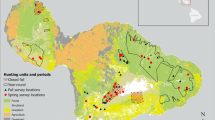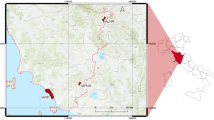Abstract
Feral pigs (Sus scrofa) occupy many different habitats worldwide. Their rooting foraging behaviour poses a serious threat to biodiversity as the resulting soil disturbance alters ecosystem structure and function. Understanding what characteristics are important in selecting rooting locations can be used to predict the impact of pigs on ecosystems. We investigated patch selection for rooting by feral pigs at two spatial scales: (1) habitat variables at a site level, and (2) dependency between observations in a spatial context. Seasonal influences on the modelled environmental variables were also examined. We applied a generalised linear modelling approach and model-averaging to explain the relative importance of variables, as measured by the standardised parameter estimates and unconditional variance. Soil texture, rock cover, soil compaction and sand texture were important explanatory variables in the presence of pig rooting. Soil compaction and distance to roads had a negative influence. The highest ranking model included seven explanatory variables with a 41 % chance that this is the Kullback–Leibler best model. Six of the 128 candidate models were in the 95 % confidence set indicating low model uncertainty. Although no differences in pig rootings were detected between seasons, most rooting (65.7 %) occurred during the dry season with soil and sand texture having the strongest effect. This study highlights how pig control programmes can focus limited resources on either the strategic positioning of control devices (e.g., traps and baits) to either reduce the number of pigs or help prioritise habitats of high conservation value for protection (e.g., exclusion fencing).






Similar content being viewed by others
References
Abaigar T, Del Barrio G, Vericad JR (1994) Habitat preference of wild boar in a Mediterranean environment: indirect evaluation by signs. Mammalia 58:201–210
Alexiou PN (1983) Effect of feral pigs (Sus scrofa) on sub-alpine vegetation of Smokers Gap, ACT. Proc Ecol Soc Aust 12:135–142
Andersen N, Redbo I (1999) Foraging behaviour of growing pigs on grassland in relation to stocking rate and feed crude protein level. Appl Animal Behav Sci 62:183–197
Arrington DA, Toth LA, Koebel JW (1999) Effects of rooting by feral hogs (Sus scrofa L.) on the structure of a floodplain vegetation assemblage. Wetlands 19:535–544
Atkinson AC (1985) Plots, transformations and regression: an introduction to graphical methods of diagnostic regression analysis. Oxford University Press, New York
Baber DW, Coblentz BE (1986) Density, home range, habitat use and reproduction in feral pigs on Santa Catalina Island. J Mammal 67:512–525
Bjørnstad ON (2009) R package ‘ncf’: spatial nonparametric covariance functions, v.1.1-2
Bjørnstad ON, Falck W (2001) Nonparametric spatial covariance functions: estimation and testing. Environ Ecol Stat 8:53–70
Booth GD, Niccolucci MJ, Schuster EG (1994) Identifying proxy sets in multiple linear regression: an aid to better coefficient interpretation. Research Paper INT-470. United States Department of Agriculture, Intermountain Research Station
Burnham KP, Anderson DR (2002) Model selection and multimodel inference: a practical information-theoretic approach. Springer, New York
Chaideftou E, Thanos CA, Bergmeier E, Kallimanis A, Dimopoulos P (2009) Seed bank composition and above-ground vegetation in response to grazing in sub-Mediterranean oak forests (NW Greece). Plant Ecol 201:255–265
Chapin FS, Matson PA, Mooney HA (2002) Principles of terrestrial ecosystem ecology. Springer, New York
Choquenot D, McIlroy J, Korn T (1996) Managing vertebrate pests: feral pigs. Australian Government Publishing Services, Canberra
Community Environmental Monitoring (2001) A simple clinometer. www.environmentmonitor.green.net.au. Accessed 22 May 2007
Cushman JH, Tierney TA, Hinds JM (2004) Variable effects of feral pig disturbances on native and exotic plants in a California grassland. Ecol Appl 14:1746–1756
Engeman RM, Constantin B, Nelson M, Woolard J, Bourassa J (2001) Monitoring changes in feral swine abundance and spatial distribution. Environ Conserv 28:235–240
Fitzpatrick RW, McKenzie N, Maschmedt DJ (1999) Soil morphological indicators and their importance to soil fertility. In: Peverill KI, Sparrow LA, Reuter DJ (eds) Soil analysis: an interpretation manual. CSIRO Publishing, Collingwood, pp 55–69
Gallo Orsi U, Sicuro B, Durio P, Canalis L, Mazzoni G, Serzotti E, Chiariglione D (1995) Where and when: the ecological parameters affecting wild boars choice while rooting in grasslands in an alpine valley. IBEX J Mt Ecol 3:160–164
Harrison DA, Congdon BC (2002) Wet tropics vertebrate pest risk assessment scheme. Cooperative Research Centre for Tropical Rainforest Ecology and Management, Cairns
Hone J (1988a) Evaluation of methods for ground survey of feral pigs and their sign. Acta Theriologica 33:451–465
Hone J (1988b) Feral pig rooting in a mountain forest and woodland: distribution, abundance and relationships with environmental variables. Aust J Ecol 13:393–400
Hone J (1995) Spatial and temporal aspects of vertebrate pest damage with emphasis on feral pigs. J Appl Ecol 32:311–319
Hone J (2007) Wildlife damage control. CSIRO Publishing, Collingwood
Jiang GS, Ma JZ, Zhang MH (2006) Spatial distribution of ungulate responses to habitat factors in Wandashan forest region, northeastern China. J Wildl Manag 70:1470–1476
Keitt TH, Bjørnstad ON, Dixon PM, Citron-Pousty S (2002) Accounting for spatial pattern when modelling organism-environment interactions. Ecography 25:616–625
Kotanen PM (1995) Responses of vegetation to a changing regime of disturbance: effects of feral pigs in a Californian coastal prairie. Ecography 18:190–199
Lacki MJ, Lancia RA (1983) Changes in soil properties of forests rooted by wild boar. Proc Annu Conf Southeast Assoc Fish Wildl Agencies 37:228–236
Laughlin K, Mendl M (2000) Pigs shift too: foraging strategies and spatial memory in the domestic pig. Anim Behav 60:403–410
Laurance WF, Harrington GN (1997) Ecological associations of feeding sites of feral pigs in the Queensland Wet Tropics. Wildl Res 24:579–590
Lavelle P (1988) Earthworm activities and the soil system. Biol Fertil Soils 6:237–251
Lee KE (1985) Earthworms: their ecology and relationships with soils and land use. Academic Press, Sydney
Lowe S, Browne M, Boudjelas S, de Poorter M (2004) 100 of the world’s worst invasive alien species: a selection from the global invasive species database. The Invasive Species Specialist Group, Auckland
Mayer JJ, Nelson EA, Wike LD (2000) Selective depredation of planted hardwood seedlings by wild pigs in a wetland restoration area. Ecol Eng 15:S79–S85
McLeod R (2004) Counting the cost: impact of invasive animals in Australia. Cooperative Research Centre for Pest Animal Control, Canberra
McNeely JA, Schutyser F (2003) Invasive species: a global concern bubbling to the surface. In: International conference on the impact of global environmental problems on continental and coastal marine waters. Geneva, Switzerland
Meriggi A, Sacchi O (2001) Habitat requirements of wild boars in the northern Apennines (N-Italy): a multi-level approach. Ital J Zool 68:47–55
Mitchell J, Mayer R (1997) Diggings by feral pigs within the Wet Tropics World Heritage Area of north Queensland. Wildl Res 24:591–601
Mitchell J, Dorney W, Mayer R, McIlroy J (2007) Spatial and temporal patterns of feral pig diggings in rainforests of north Queensland. Wildl Res 34:597–602
Mohr D, Topp W (2001) Forest soil degradation in slopes of the low mountain range of Central Europe: do deer matter? Forstwissenschaftliches Centralblatt 120:220–230
Mohr D, Cohnstaedt LW, Topp W (2005) Wild boar and red deer affect soil nutrients and soil biota in steep oak stands of the Eifel. Soil Biol Biochem 37:693–700
Nelson P (2006) Applied soil sciences (EA2007) practical manual. James Cook University, Cairns
Pavlov PM, Crome FHJ, Moore LA (1992) Feral pigs, rainforest conservation and exotic disease in north Queensland. Wildl Res 19:179–193
Ralph CJ, Maxwell BD (1984) Relative effects of human and feral hog disturbance on a wet forest in Hawaii. Biol Conserv 30:291–303
Senft RL, Coughenour MB, Bailey DW, Rittenhouse LR, Sala OE, Swift DM (1987) Large herbivore foraging and ecological hierarchies. Bioscience 37:789–799
Silver WL, Neff J, Mcgroddy M, Veldkamp E, Keller M, Cosme R (2000) Effects of soil texture on belowground carbon and nutrient storage in a lowland Amazonian forest ecosystem. Ecosystems 3:193–209
Singer FJ, Swank WT, Clebsch EEC (1984) Effects of wild pig rooting in a deciduous forest. J Wildl Manag 48:464–473
Smith M (1999) Natural resource monitoring guide: a practical guide for detecting changes occurring at the property or catchment level. Department of Natural Resources, Coorparoo
Spain AV, Prove BG, Hodgen MJ, Lee KE (1990) Seasonal variation in penetration resistance and shear strength of three rainforest soils from northeastern Queensland. Geoderma 47:79–92
Stephens PW, Krebs JR (1986) Foraging theory. Princeton University Press, New Jersey
Stocker GC, Thompson WA, Irvine AK, Fitzsimon JD, Thomas PR (1995) Annual patterns of litterfall in a lowland and tableland rainforest in tropical Australia. Biotropica 27:412–420
Stone CP (1985) Alien animals in Hawaii’s native ecosystems: toward controlling the adverse effects of introduced vertebrates. In: Stone CP, Scott JM (eds) Hawaii’s terrestrial ecosystems: preservation and management. University of Hawaii Press, Honolulu, pp 251–297
Sutherst RW (2000) Climate change and invasive species: a conceptual framework. In: Mooney HA, Hobbs RJ (eds) Invasive species in a changing world. Island Press, Washington, pp 211–240
Theuerkauf J, Rouys S (2008) Habitat selection by ungulates in relation to predation risk by wolves and humans in the Bialowieza Forest, Poland. For Ecol Manag 256:1325–1332
Vtorov IP (1993) Feral pig removal: effects on soil microarthropods in a Hawaiian rain forest. J Wildl Manag 57:875–880
Walsh C, Mac Nally R (2008) R package ‘hier.part’: hierarchical partitioning, v.1.0-3
Yolcubal I, Brusseau MF, Artiola JF, Wierenga P, Wilson LG (2004) Environmental physical properties and processes. In: Artiola JF, Pepper IL, Brusseau M (eds) Environmental monitoring and characterization. Elsevier Academic Press, London, pp 207–239
Acknowledgments
This study was funded by the Invasive Animals Cooperative Research Centre (IA-CRC) and the Commonwealth Scientific and Industrial Research Organisation (CSIRO). The authors are grateful to the Kuku Yalanji Traditional Owners and Queensland Parks and Wildlife Service for access to the study sites. We thank Bilyana Miroak, Elizabeth ‘Ceinwen’ Edwards, Victoria Lake and Michiel Steenhauer for assistance with fieldwork; Greg Keith (Queensland Parks and Wildlife Service), Paul Nelson (James Cook University, JCU), Suzanne Berthelsen (JCU, formerly CSIRO) and Peter Logan (Cairns Regional Council, formerly Douglas Shire Council) for their contribution and support. We also thank Renee Treml (The University of Queensland, UQ) for GIS maps; Michael Liddell (JCU) for use of climatic data collected at the Australian Canopy Crane Research Facility in Cape Tribulation; and Bronwyn Price (UQ), Michiala Bowen (UQ) and Jonathan Rhodes (UQ) for assistance with R scripts. David Westcott (CSIRO), Dan Metcalfe (CSIRO) and two other anonymous reviewers provided helpful comments on an earlier draft.
Author information
Authors and Affiliations
Corresponding author
Rights and permissions
About this article
Cite this article
Elledge, A.E., McAlpine, C.A., Murray, P.J. et al. Modelling habitat preferences of feral pigs for rooting in lowland rainforest. Biol Invasions 15, 1523–1535 (2013). https://doi.org/10.1007/s10530-012-0387-6
Received:
Accepted:
Published:
Issue Date:
DOI: https://doi.org/10.1007/s10530-012-0387-6




